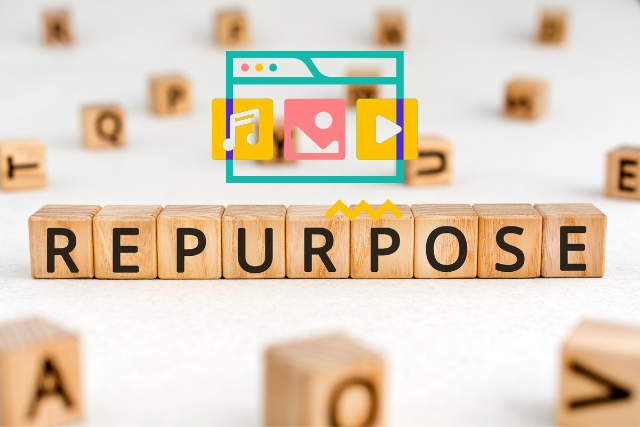Content creation can be time-consuming and costly. But what if you could get more mileage out of the material you’ve already created—or even better—repurpose other people’s content (with permission) to expand your reach? Repurposing content is a powerful strategy that helps breathe new life into existing material while reaching different audiences across multiple platforms.
In this guide, we’ll explore the benefits, methods, and ethical considerations involved in repurposing content, offering actionable tips to help you boost visibility and engagement.
The Benefits of Repurposing Content
Repurposing content means taking a piece of content and adapting it to serve a new purpose, medium, or audience. This strategy has several benefits:
- Saves Time and Effort: Instead of starting from scratch, you’re building on existing material.
- Maximizes Reach: By transforming content into new formats, you can reach audiences on different platforms.
- Enhances Brand Credibility: Sharing fresh perspectives on well-researched material showcases your expertise.
- Increases SEO Value: Repurposed content adds more touchpoints for your website, improving your rankings in search results.
By understanding how to repurpose content effectively, you can significantly enhance your brand presence with minimal additional effort.
Ethical Considerations When Repurposing Content
While repurposing content is an excellent strategy, it’s crucial to adhere to ethical standards. Respecting creators’ rights and following legal guidelines will help you avoid potential issues. Here’s what to keep in mind:
Respecting Intellectual Property (IP)
Intellectual property (IP) refers to creations like articles, videos, images, or music. When repurposing content, always ensure you respect IP rights by following these steps:
- Seek Permission: Always ask the original creator for permission to repurpose their work.
- Use Licensed Content: Consider using content that offers more flexibility, like those licensed under Creative Commons.
- Credit the Creator: Even when using content with permission, always give proper attribution.
By following these rules, you foster trust within the creative community and build strong relationships with content creators.
Understanding Fair Use
Fair use allows limited use of copyrighted material without permission, but it comes with restrictions. Key factors in determining fair use include:
- Purpose: The use should be educational or transformative.
- Impact: It should not negatively affect the market value of the original work.
- Amount: Only a small portion of the work should be used.
Always credit the original author to show respect for their work. For example, when citing an article, include the title and the author’s name:
- “Article Title” by Author Name
This simple practice enhances transparency and protects you from potential legal consequences.
Identifying Valuable Content to Repurpose
Not all content is worth repurposing. Focus on high-quality material that resonates with your target audience. Here are some guidelines for selecting valuable content:
Criteria for Selection
- Relevance: Ensure the content aligns with your industry or niche.
- Engagement: Look for content that has already attracted likes, shares, or comments.
- Credibility: Prioritize material from authoritative sources.
- Timeliness: Recent content often holds more relevance and impact.
- Uniqueness: Fresh, original perspectives are more likely to stand out.
Sources of High-Impact Content
There are various platforms where you can find high-quality content to repurpose:
| Source | Description |
|---|---|
| Blogs | Expert opinions and industry trends. |
| Social Media | Trending topics and audience reactions. |
| Podcasts | In-depth discussions from thought leaders. |
| Webinars | Educational content that offers unique insights. |
| Research Papers | Data-driven insights that add value to your content. |
Explore these platforms to find content that can be adapted to fit your brand strategy.
Transforming Written Content into Engaging Formats
One of the most effective ways to repurpose content is by transforming written material into more engaging formats. Two highly effective methods include converting blog posts into infographics and creating eBooks from articles.
From Blog Posts to Infographics
Infographics are visually engaging and simplify complex information. Here’s how to convert a blog post into an infographic:
- Identify Key Points: Choose the most relevant data from the blog.
- Use Visuals: Incorporate charts, graphs, and icons to illustrate your points.
- Keep Text Minimal: Focus on making the infographic visually appealing with concise text.
- Use Design Tools: Tools like Canva and Piktochart are great for creating infographics.
- Share on Social Media: Promote your infographic across various platforms for maximum reach.
This method allows you to diversify your content while increasing engagement with visually-oriented audiences.
Creating eBooks from Articles
Turning multiple articles into an eBook is another effective way to establish yourself as an expert. Here’s a step-by-step process:
- Compile Related Articles: Gather blog posts on similar topics.
- Revise for Clarity: Edit the articles for clarity and flow.
- Add New Insights: Include updated information or case studies to enhance value.
- Design a Cover: An attractive cover makes your eBook look professional.
- Format for eBook: Ensure the content is readable on various devices.
Offering an eBook as a free download can help you build your email list and increase brand awareness.
Leveraging Video Content for Multiple Platforms
Video content can be repurposed across multiple formats, including podcasts and training courses, maximizing its value.
Turning Video Clips into Podcasts
Podcasts are a popular format that allows you to repurpose video content into something accessible for on-the-go listeners. Follow these steps:
- Extract Audio: Use tools like Audacity to extract the audio from video content.
- Edit for Flow: Remove unnecessary sections and smooth transitions.
- Add an Intro and Outro: Polish the podcast with a branded intro and outro.
- Upload to Podcast Platforms: Platforms like Spotify or Apple Podcasts can expand your audience reach.
This method offers a new channel for reaching your audience and drives engagement through audio content.
Compiling Webinars into Training Courses
Webinars are rich in information. Repurpose them into structured training courses to provide even more value:
- Record Webinars: Always record your webinars for later use.
- Segment into Modules: Break down the webinar into smaller lessons or modules.
- Add Resources: Supplement the course with quizzes, PDFs, or resources.
- Host on Learning Platforms: Use platforms like Udemy or Teachable to deliver the course.
This approach adds depth to your content while enabling learners to dive deeper into the material.
Maximizing Social Media Posts for Broader Reach
Social media is the perfect platform to repurpose content and reach new audiences. Repurposing social media content saves time and boosts visibility.
Curating Content for Newsletters
Newsletters are a powerful way to engage your audience. Curating content from external sources enhances their value. Follow these steps:
- Find Trusted Sources: Select reputable blogs or websites.
- Summarize Key Points: Provide concise summaries of the most relevant content.
- Credit the Authors: Always credit the original authors.
Curating content for newsletters can diversify your audience and encourage engagement, providing a well-rounded view of your niche.
Turning Tweets into Instagram Stories
A simple yet effective way to repurpose content is by transforming popular tweets into Instagram Stories:
- Choose a Popular Tweet: Select tweets that have gained significant engagement.
- Take a Screenshot: Capture the tweet.
- Add Creative Elements: Enhance with stickers, emojis, or music.
- Share on Instagram Stories: Post it to engage your Instagram followers.
This tactic combines platforms, enhancing interaction and visibility.
Legal Considerations in Content Repurposing
Before repurposing content, it’s crucial to understand the legal landscape. Failing to follow copyright laws can lead to legal troubles. Here are key points to keep in mind:
Understanding Copyright Laws
Copyright laws protect original works, including text, images, videos, and music. Using copyrighted material without permission can lead to fines or lawsuits. Always check the content’s copyright status before repurposing it.
Securing Permissions
If you plan to repurpose someone else’s work, follow these steps to secure permissions:
- Identify the Creator: Find the original content owner.
- Reach Out: Contact them to ask for permission.
- Explain Usage: Clearly outline how you intend to use their content.
- Request Written Consent: Secure written permission to avoid disputes.
When securing permission, always keep a record of communications for legal protection.
SEO Benefits and Pitfalls of Content Repurposing
Repurposing content can have a significant impact on your site’s SEO, but it’s essential to avoid common pitfalls like duplicate content penalties.
Avoiding Duplicate Content Penalties
Search engines like Google dislike duplicate content and can penalize your site for using the same material multiple times. Here are some tips to avoid penalties:
- Give Credit: Always cite the original source.
- Use Fresh Summaries: Instead of copying, rewrite and summarize the content in your own words.
- Diversify Formats: Convert written content into videos or infographics.
Tools like Copyscape can help ensure that your content remains original and penalty-free.
Enhancing Your Site’s SEO
When done correctly, repurposing content can improve your SEO. Here’s how to maximize SEO benefits:
- Optimize Keywords: Use targeted keywords in your repurposed content.
- Use Internal Links: Link to other relevant pages on your website.
- Add Visuals: Include images or videos to enhance user experience.
- Promote on Social Media: Boost visibility by sharing repurposed content across platforms.
By following these steps, you’ll improve your search rankings while driving more traffic to your site.
Measuring the Impact of Content Repurposing
Measuring the effectiveness of repurposed content is crucial to refining your strategy. Here are some tools and metrics to track success:
Tools for Tracking Success
Several analytics tools can help you measure the impact of your repurposed content:
- Google Analytics: Monitor website traffic and user behavior.
- Social Media Insights: Measure engagement on platforms like Instagram and Facebook.
- BuzzSumo: Track how content is performing across social channels.
- SEMrush: Analyze keyword rankings and organic traffic.
Analyzing Engagement and Reach
When evaluating your repurposed content, focus on these key metrics:
| Metric | How to Measure |
|---|---|
| Engagement | Likes, shares, and comments. |
| Reach | Impressions and unique views. |
| Traffic Sources | Referral, direct, and organic traffic. |
| Conversion Rates | Sign-ups, purchases, or clicks. |
Use this data to fine-tune your content strategy and improve future efforts.
Best Practices for Repurposing Content
Repurposing content is an art that requires strategy and careful planning. Follow these best practices to maintain integrity and respect for original creators.
Maintaining Brand Consistency
Consistent branding is critical for trust and recognition. When repurposing content, ensure it aligns with your brand voice and style:
- Use Brand Colors: Keep visuals aligned with your existing branding.
- Adopt Your Brand Tone: Ensure the language matches your brand’s voice.
- Include Your Logo: Add branding elements for a cohesive look.
Consider using templates to ensure consistency across all content formats.
Engaging with the Original Creators
Building strong relationships with original creators can lead to valuable collaborations. Here’s how to foster engagement:
- Ask for Permission: Always request approval before using their content.
- Credit the Source: Acknowledge the creator in your work.
- Share Your Work: Let them know when you publish their content.
- Encourage Collaboration: Explore potential opportunities for future partnerships.
Engaging with content creators is an excellent way to expand your network and increase credibility.
FAQs
How Can I Repurpose Content Legally?
To repurpose content legally, always seek permission from the original creator or ensure it’s under a Creative Commons license. You can also transform the content with your own insights, which minimizes the risk of copyright infringement.
What Types of Content Can Be Repurposed?
You can repurpose blog posts, videos, podcasts, and social media content. For instance, a blog post can be turned into an infographic or an eBook, expanding its reach across multiple platforms.
Why Should I Repurpose Content?
Repurposing content saves time, increases reach, and improves SEO by providing more entry points for search engines to find your material. It also ensures you engage with different audiences across various formats.
What Are Some Tips for Effective Repurposing?
Start by identifying high-performing content and consider how to adapt it for different platforms. Ensure each new format adds value, whether through updated insights or multimedia elements like images and videos.
How Can Repurposing Content Enhance My SEO?
Repurposing content boosts SEO by increasing traffic, improving engagement, and offering more opportunities for keyword optimization. Just be sure to avoid duplicate content penalties by keeping each version unique.
How Do I Measure the Success of Repurposed Content?
Track the success of your repurposed content by analyzing engagement, reach, and conversions using tools like Google Analytics, BuzzSumo, and SEMrush.







